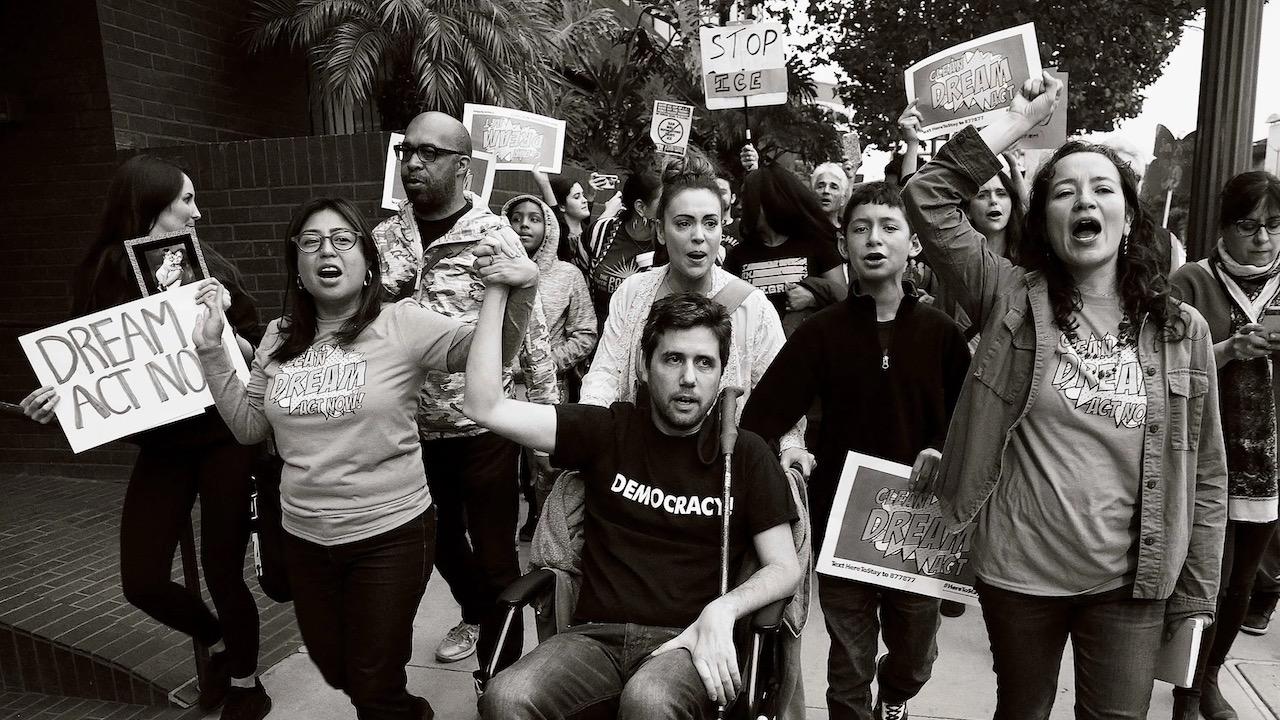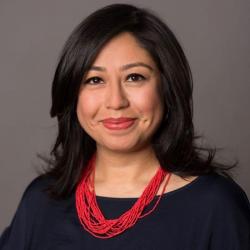On Election Day in 2016, United We Dream (UWD) members and their families gathered across the country to watch the election results. I was in UWD’s Washington, DC, office with my mom and aunts as well as our members and staff. The crowd was hopeful. Young people and their family members wore orange UWD t-shirts, chatting and taking selfies as they watched the early results stream on CNN. We were confident. We had done the work to mobilize voters, and the polls indicated Hillary Clinton would triumph. But, as the night wore on, it became clear that the man who had declared war on immigrants would be next President of the United States.
My mom looked at me and asked, “Mija, que vamos hacer?” What are we going to do? Trump had promised to hunt down immigrants, lead mass deportations, and kill DACA, which protects my brother and over 600,000 immigrant youth from deportation. Despite my fear, I steeled myself. “We will fight back.” Immediately after Trump was declared the winner, we marched to the White House for an impromptu rally to defend our communities.
Many within our progressive community did not think Trump would act on his hateful rhetoric once he was in the White House. But Black, brown, Indigenous, and immigrant communities knew that Trump had not been acting; white nationalists and white supremacists were part of his campaign and advised his policy agenda. Our worst fears soon became a reality. In his first week as President, Trump issued executive orders to approve the construction of the Keystone XL and Dakota Access pipelines, ban Muslims from coming to the U.S., start the construction of a wall along the U.S - Mexico border, and make all undocumented immigrants a priority for deportation. In the months to come, he terminated DACA, putting thousands of young people who had trusted the government with their information at risk of deportation; issued a zero-tolerance policy caging thousands of children and separating them from their parents; dismantled the country’s refugee program; and unleashed the racist forces of Immigration and Customs Enforcement (ICE) and Customs and Border Patrol (CBP) to hunt people down in their homes, at school drop-off, or at the hospital. In the four years Trump held office, more than twenty immigrants, including children, died in detention, and hundreds of women were forcibly sterilized.
Thousands of immigrants and allies came together to fight back against Trump’s white nationalist policies and defend Muslims and immigrants. We took over airports, courtrooms, and streets across the country, putting our bodies on the line in solidarity to defend communities under attack. In this special issue of The Forge, we discuss the lessons from our organizing and movement-building work over the last four years.
One of the most important lessons for me is the power of radical solidarity. Established and new movement organizations — including Move On, Planned Parenthood, Indivisible, Center for Popular Democracy, and Women’s March — mobilized their members to defend Muslim, immigrant, and refugee communities. This larger community, made up of both immigrants and non-immigrants, became increasingly active in the fight for immigrant justice. This was the first time in more than a decade of organizing in immigrant communities that I experienced this kind of solidarity. As Carmen Perez Jordan, National Co-chair of the Women’s March, shares in her piece, we built intersectional, muli-racial coalitions and did the hard work to politicize millions of new people who joined our movements. Together, we defended DACA; forced the closing of detention camps from Florida to Oklahoma; marched for workers’ rights, women’s rights, and a Green New Deal; joined the largest movement in this country’s history to defend Black lives; and called for abolishing ICE and defunding the police. We not only marched on the streets; we also marched to the polls to defeat Trump, activating millions of new voters and flipping states like Arizona and Georgia with innovative strategies, as Nsé Ufot from the New Georgia Project (NGP) recounts in this issue. In the midst of national outrage and pain, we took a united stand against white supremacy, systematic racism, and patriarchy.
As we move into a new political landscape, we must maintain the radical solidarity that our movements put in practice under the Trump administration. As Linda Sarsour argues in this issue, “solidarity is a verb…. [W]e must stop pushing policies, campaigns, or narratives that leave communities out because we believe it is more strategic.” In fact, as Nikayla Jefferson of the Sunrise Movement and Patrice Lawrence of Undocublack argue, solidarity means not only including those most impacted by injustice in the conversation but actually centering, following, and supporting their leadership. In United We Dream, we say that those closest to the pain and injustice are closest to the solutions and breakthroughs we seek. Supporting the leadership of those most impacted requires us to see the people in our own movements as whole people, acknowledging their lived experiences as well as the pain, trauma, joy, and resilience that all of us bring into the transformational and difficult work of movement building. We must ensure that our organizations and movements center healing justice and radical self-care.
One of the biggest victories of the last four years was bringing the impact of white supremacy and racism into public consciousness. This creates an unprecedented opportunity for us, as organizers and movement builders, to bring along the unorganized, recruit new people into our movements, and build more power to advance our vision for justice. But we won’t be able to create a true multi-racial democracy where all of us can thrive unless we recognize that we are up against powerful forces: white supremacy, racial capitalism, and a growing white nationalist movement. As Silky Shah, the Executive Director of Detention Watch Network, lifts up in her piece in this issue, systems of oppression like mass incarceration and immigrant detention are interconnected, rooted in white supremacy and relying on the same infrastructure to control Black and brown bodies.
The violent insurrection of January 6 — and the Senate’s failure to convict Trump for his role in instigating it — makes clear that we are in an ongoing battle against authoritarianism. This battle is daunting, but we also know that, when we organize, we can win, and that our movements have the power to disrupt the narrative, build strong labor unions, win elections, bring in new people, and build coalitions to dismantle the forces that oppress us. As we do this work, we must also do the work to address anti-Blackness, misogyny, and systematic racism within the communities we organize. We must keep building governing power and be ready to hold our elected leaders accountable. And we must be unapologetic about our vision for this country and inspire millions to dream with us about building a new story and a new country where all of us live with dignity and thrive.
Inside the Issue
Arlene Inouye and Jackson Potter on building strike-ready unions to win common good demands; Carmen Perez on the multi-racial coalition behind the 2017 Women’s March; Jabari Brisport on DSA’s electoral work; Josh Kaplowitz on organizing families in the Virginia suburbs; Linda Sarsour on unapologetic solidarity; Luisa Boyarski on coalition building with Northern Virginia’s grassroots resistance groups; Monica Hutchinson on why Black women and women of color need their own organizing spaces; Nikayla Jefferson on the lessons the Sunrise Movement has learned over the past four years; Nikil Saval on why we need to begin party building; Nsé Ufot on New Georgia Project's strategies for engaging new voters and fighting voter suppression; Patrice Lawrence on organizing Black immigrant communities during the Trump years; Silky Shah on why the immigrant justice movement needs to embrace abolition; and Trevor Wild on building the March For Our Lives distributed organizing team.

